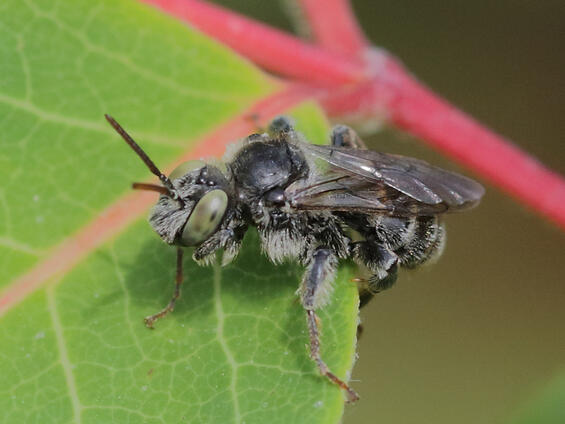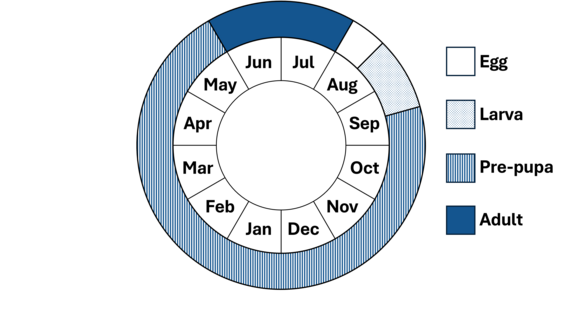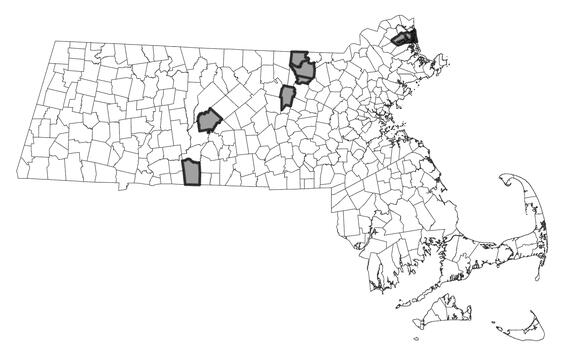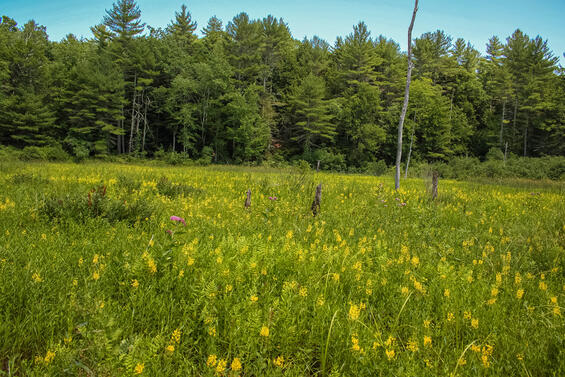- Scientific name: Epeoloides pilosulus
- Species of Greatest Conservation Need (MA State Wildlife Action Plan)
- Threatened (MA Endangered Species Act)
Description

Macropis cuckoo bee (Epeoloides pilosulus)
The macropis cuckoo bee (Epeoloides pilosulus) is relatively small, 7-10 mm (0.28-0.39 inch) in length, with a compact body that is black in color. The male has moderately long, feathery white setae (hairs) on the head and sides of the thorax. The female lacks these pollen-carrying setae and has a more “wasp-like” appearance. In both sexes the lower front of the face protrudes. The thorax is raised above the top of the head, giving the bee a “hump-backed” appearance in profile. The abdomen is noticeably pointed, with narrow white bands of setae that in older individuals may be worn and appear absent. The legs are unusually robust, especially in the male. In the female the inner edges of the eyes are nearly parallel; in the male they are angled inward (Mitchell 1962, Ascher 2005).
Life cycle and behavior

The macropis cuckoo bee is a brood parasite of solitary, ground nesting “oil bees” in the genus Macropis. Three species of Macropis are known from Massachusetts; they specialize in collecting both oil and pollen from flowers of native yellow loosestrifes (Lysimachia ciliata, L. quadrifolia, and L. terrestris). The oil is used to line the brood cells in the nest, and both oil and pollen provide food for the larvae. In Massachusetts, adult macropis cuckoo bees fly in June and July, corresponding to peak nesting season of Macropis oil bees, as well as peak flowering of yellow loosestrifes. Because flowers of yellow loosestrifes do not produce nectar, both the macropis cuckoo bee and Macropis oil bees need to visit other flowers for nectar. Macropis cuckoo bees are often found at nectar-producing flowers, sometimes together with Macropis oil bees. Both the macropis cuckoo bee and Macropis oil bees are particularly attracted to dogbanes (Apocynum).
Current knowledge of the life cycle and behavior of the macropis cuckoo bee is partial, but a study of the European macropis cuckoo bee (Epeoloides coecutiens) (Bogusch 2005) and what is known about other brood parasites of ground nesting bees (Danforth et al. 2019) provide insight. The female macropis cuckoo bee likely locates Macropis oil bee host nests by visual searching and chemical detection (odor). Searching flight, low over the ground near Macropis oil bee nesting areas has been observed in Massachusetts (Veit, pers. comm.). The European macropis cuckoo bee has been observed making a similar searching flight near host nests, as well as “shadowing” female Macropis oil bees (Bogusch 2005). Because a Macropis oil bee female will defend its nest, the macropis cuckoo bee is only successful in entering a host nest when the host is absent. Once in the host nest, the macropis cuckoo bee finds a brood cell in the appropriate stage of completion and deposits a single egg inside the cell. After the host bee completes provisioning the cell and deposits her own egg, the cell is sealed. Depending on when it hatches, the macropis cuckoo bee larva will either destroy the host egg or kill the host larva; it then feeds on the provisions. The larva molts four times before the fifth molt forms the pre-pupa. The pre-pupal stage overwinters, with pupation in spring or early summer. Adult macropis cuckoo bees emerge slightly earlier, or at the same time, as emergence of Macropis oil bees.
Distribution and abundance
The historic range of the macropis cuckoo bee extended from Nova Scotia south to Georgia, and west to Alberta and Nebraska (Ascher & Pickering 2020). Recent records are from New England and the Great Lakes region. In Massachusetts, the macropis cuckoo bee occurs in the central and northeastern parts of the state.

Distribution in Massachusetts.
1999-2024
Based on records in the Natural Heritage Database.
Habitat
In Massachusetts, the macropis cuckoo bee has been found only at locations having large concentrations of native yellow loosestrifes (Lysimachia spp.). Presumably a large concentration of host plants is necessary to support a sufficiently large population of Macropis oil bees to in turn sustain a population of the macropis cuckoo bee. Fourflower yellow loosestrife (Lysimachia quadrifolia) is most abundant in open upland habitat, including sandplain habitats with fire disturbance, or anthropogenic disturbance such as utility line rights-of-way. Fringed yellow loosestrife (L. ciliata) and swamp yellow loosestrife (L. terrestris) occur in wetlands and wetland margins such as marshes, wet meadows, river or stream floodplains, and lake shores, where flooding maintains open habitat.
Healthy habitats are vital for supporting native wildlife and plants. Explore habitats and learn about conservation and restoration in Massachusetts.

Marsh with swamp yellow loosestrife (Lysimachia terrestris), habitat for the macropis cuckoo bee. Habitat managed by Nashoba Conservation Trust.
Threats
The macropis cuckoo bee is threatened by habitat loss and fire suppression in its disturbance-dependent sandplain habitats. In its wetland habitats, hydrologic alteration, invasion by exotic plants, and eutrophication or other water pollution are major threats. Other potential threats include excessive deer browse of host plants, introduced pathogens, aerial insecticide spraying, non-target herbicide application, and off-road vehicles. The macropis cuckoo bee is a northern species, likely vulnerable to a warming climate.
Conservation
Land protection and habitat management are the primary conservation needs of the macropis cuckoo bee in Massachusetts. Both upland sandplain habitats and wetlands/wetland margins with native yellow loosestrifes should be conserved, restored, and managed to maintain habitat for this species and other species dependent on such habitats.
Survey and monitoring
In Massachusetts, survey effort for the macropis cuckoo bee has been significant. Nevertheless, undocumented populations may yet be found. Known populations of this species should be surveyed to document persistence at least once every 25 years; every 10 years is more desirable when practicable.
Management
Management of upland sandplain habitats, as well as wetland habitats, maintains a diversity of native species. Disturbance such as prescribed fire is needed in upland habitat, while in wetlands restoration and maintenance of natural hydrology and control of common reed (Phragmites australis), purple loosestrife (Lythrum salicaria), reed canary grass (Phalaris arundinacea), and other invasive exotic plants are of primary importance. Habitat condition should be monitored and management adapted as needed.
Research needs
While partially understood, the natural history and conservation needs of the macropis cuckoo bee need further study as applicable to this species in Massachusetts. A better understanding is needed of the relationship between this species and its Macropis oil bee hosts, including investigation of host population size needed to sustain a population of the macropis cuckoo bee. In addition, the future effects of a warming climate on this species are unpredictable and should be documented.
Acknowledgements
Michael F. Veit has contributed significantly to knowledge of the macropis cuckoo bee in Massachusetts, and provided much of the information presented here.
References
Ascher, J.S. 2005. Species profile: Epeoloides pilosula. In: Shepherd, M.D., D.M. Vaughan, and S.H. Black (eds). Red List of Pollinator Insects of North America. The Xerces Society for Invertebrate Conservation, Portland, Oregon.
Ascher, J.S., and J. Pickering. 2020. Discover Life bee species guide and world checklist (Hymenoptera: Apoidea: Anthophila). http://www.discoverlife.org/mp/20q?guide=Apoidea_species.
Bogusch, P. 2005. Biology of the cleptoparasitic bee Epeoloides coecutiens (Hymenoptera: Apidae: Osirini). Journal of the Kansas Entomological Society 78: 1-12.
Danforth B.N., R.L. Minckley, and J.L. Neff. 2019. The Solitary Bees: Biology, Evolution, Conservation. Princeton University Press, Princeton, New Jersey. 488 pp.
Mitchell, T.B. 1962. Bees of the Eastern United States. Volume 2. North Carolina Agricultural Experiment Station Technical Bulletin No. 152, Raleigh, North Carolina. 557 pp.
Veit, M.F. 2025. Personal communication. March 2, 2025.
Contact
| Date published: | March 28, 2025 |
|---|